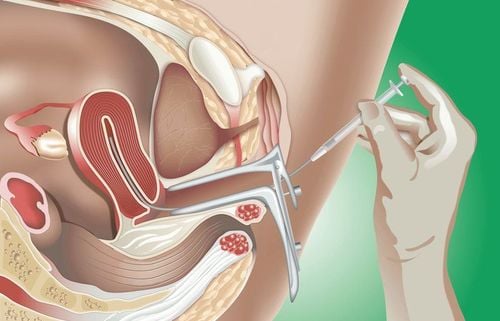This is an automatically translated article.
Laparoscopic surgery is both a diagnostic method and has a therapeutic role in some cases of infertile women with uterine, ovarian, endometrial diseases...1. Causes of Infertility
Infertility as defined by the World Health Organization is when a couple lives together for more than a year, without using any contraceptive method, and still does not have children.
There are many causes of infertility, in which, according to studies, 30-40% of infertility is caused by men, 40% of causes by women, 10% by a combination of both men and women, and 10% not clear cause.
Causes of female infertility may be due to:
Ovulation abnormalities; Due to diseases that cause damage to the fallopian tubes such as: Genital infections, endometriosis. Congenital abnormalities of the fallopian tubes; due to damage to the uterus such as uterine fibroids , ovarian adhesions . Congenital abnormalities of the uterus or cervical causes such as short cervix, cervical damage due to surgical intervention, ...
2. Laparoscopic surgery to diagnose infertility and laparoscopic surgery to treat infertility
There are many methods of infertility treatment, after examining, based on the cause of infertility, the doctor will prescribe the appropriate treatment for infertility. In particular, laparoscopic surgery is both a diagnostic method and a treatment modality for female infertility patients. Laparoscopy for infertility treatment is usually indicated after:
X-ray and ultrasound results show that the patient has abnormalities in the uterus, fallopian tubes, ovaries, fallopian tubes, and ovarian cysts. The patient failed to implant many times for unknown reasons

Nội soi buồng tử cung giúp chẩn đoán vô sinh
3. Laparoscopic surgery for infertility treatment
Infertility treatment by laparoscopic surgery is done in two steps:
3.1 Step 1: Laparoscopy to diagnose infertility
The doctor conducts hysteroscopy, the laparoscope with a camera is inserted into the body through the vagina, to the uterus and transmits image signals to the screen. The doctor will examine the structure of the uterus, see if the patient has uterine malformations, uterine polyps, uterine adhesions, uterine fibroids, etc., which affect the implantation process of the fetus. After the hysteroscopy, the doctor will perform a laparoscopy. The laparoscope with a camera is inserted into the patient's abdomen through a small incision in the abdominal wall. The doctor will examine the organs in the abdomen, see if the patient has diseases that affect the reproductive function such as endometriosis, pelvic adhesions, tubal fluid retention, ... or not. .
3.2 Step 2: Laparoscopic surgery for infertility treatment
After the endoscope accurately identifies abnormalities and lesions that affect the patient's fertility, the doctor will proceed to solve those causes right in the surgery. The commonly performed techniques are:
Laparoscopic removal of endometrioma lesions: The surgeon will remove endometrioid lesions in all locations such as the peritoneum, bladder fundus, and peritoneum. covering the ureter, calyx ligament of the kidney, pelvis, anterior abdominal wall, serosa of intestine; The entire endometriosis tumor will be removed in its entirety to prevent recurrence. Laparoscopic surgical removal of endometrial lesions has been shown to be beneficial in infertile women, helping to improve fertility. Laparoscopic tubal catheterization: When the fallopian tubes are blocked, it will cause infertility or ectopic pregnancy, seriously affecting health. After laparoscopic detection of fallopian tube blockage, the doctor will perform laparoscopic surgery to clear the fallopian tubes by placing the laparoscopic surgery unit into the uterus, inserting a catheter into the fallopian tube hole to push out the debris. as well as separation of adhesions in the lumen of the fallopian tube. If the fallopian tube is attached, the doctor will surgically remove the sticky bands around the fallopian tube and tube. When the fallopian tubes are blocked with fluid, the doctor will open the fallopian tubes to make it easier for sperm to move to fertilize an egg. Laparoscopic hysterectomy: Patients with submucosal fibroids or intramuscular fibroids that cause uterine deformity have low fertility. Surgical removal of submucosal fibroids or intramuscular fibroids that cause uterine deformity will significantly increase pregnancy rates. Compared with open surgery, laparoscopic fibroid removal has many advantages such as small incision, short hospital stay, less postoperative pain, and quick recovery. In addition, other techniques can be performed during laparoscopic surgery to treat infertility such as tubal reconstruction, ovarian cyst surgery, genital malformations, etc. As well as invasive surgical procedures. patients who undergo laparoscopic surgery to diagnose and treat infertility may experience complications such as pneumothorax, infection, pleural effusion, etc. However, compared with laparotomy, the rate is Complications during laparoscopic surgery are very low, the degree of injury is usually mild, and the patient recovers quickly.

Trung tâm hỗ trợ sinh sản IVF Vinmec
Vinmec Reproductive Center is the leading modern center in Vietnam, built and applied a comprehensive medical examination and treatment process, combining both male and female obstetrics and gynecology to offer the optimal plan. for each patient case. Up to now, Vinmec IVF fertility center has provided fertility support to over 1000 infertile couples with a success rate of over 40%. This rate is equivalent to developed countries such as UK, USA, Australia,...
With high professional level and extensive experience, Vinmec's team of experts is capable of deploying. Synchronize and comprehensively the most advanced assisted reproductive techniques today, helping to realize the dream of parenthood of hundreds of families across Vietnam.
To register for examination and treatment at Vinmec International General Hospital, you can contact Vinmec Health System nationwide, or register online HERE.













